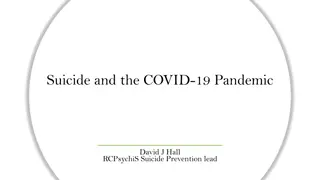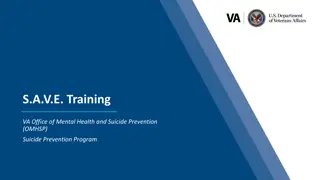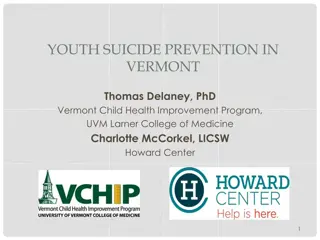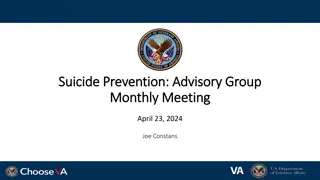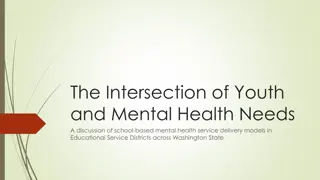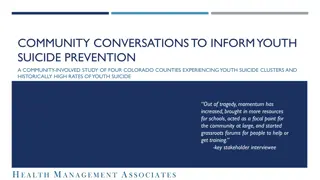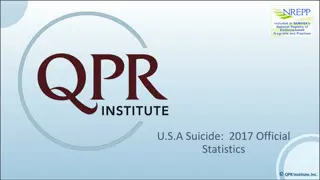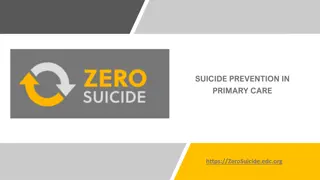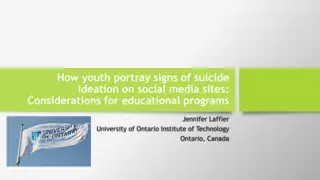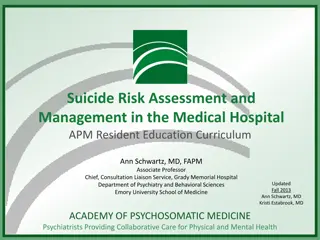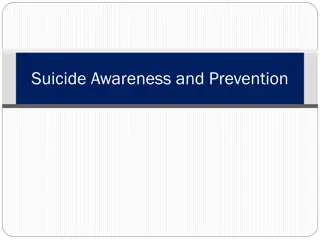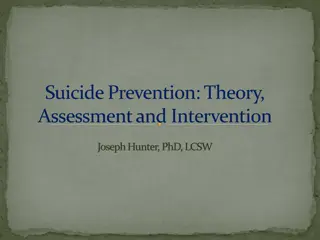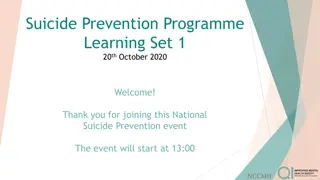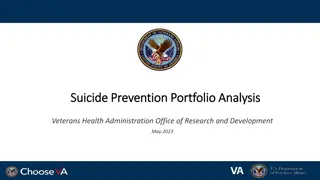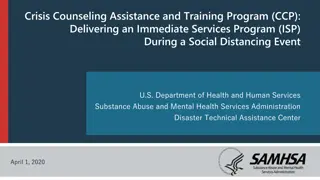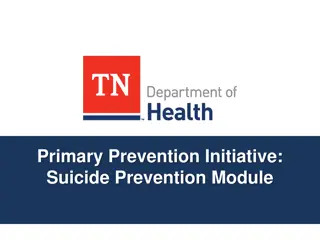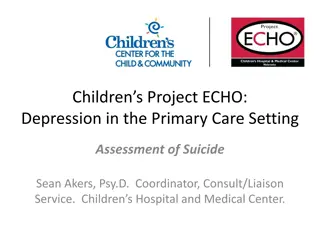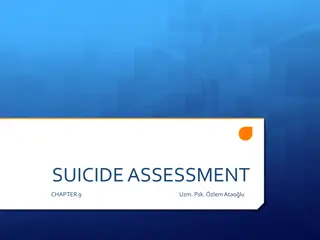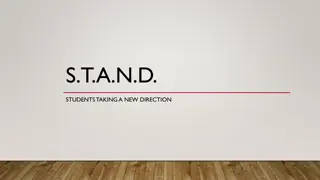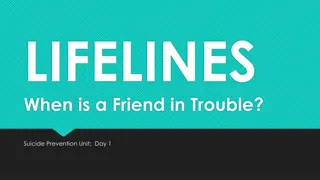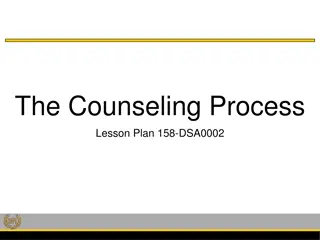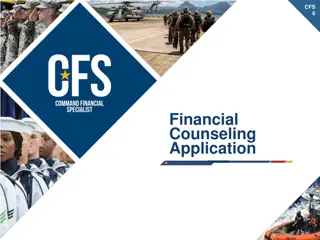Suicide Prevention Program: Creating Change Through Counseling and Outreach
This program aims to reduce risk factors, increase healthy coping mechanisms, and decrease stigma associated with suicidal thoughts and behaviors. It focuses on individual, family, and community-based approaches to help those in distress, promote healing and recovery, and provide necessary support and resources. Curriculum topics include building a safe community, addressing stigma, effective communication, and self-care planning. Recognizing warning signs and engaging in proactive strategies are essential components of this initiative.
Download Presentation

Please find below an Image/Link to download the presentation.
The content on the website is provided AS IS for your information and personal use only. It may not be sold, licensed, or shared on other websites without obtaining consent from the author. Download presentation by click this link. If you encounter any issues during the download, it is possible that the publisher has removed the file from their server.
E N D
Presentation Transcript
BUCKELEW SUICIDE PREVENTION PROGRAM: Creating Change Through Counseling, Outreach, Education and Training REDUCE RISK FACTORS, INCREASE HEALTHY COPING AND RESILIENCY, AND REDUCE STIGMA PREVENTION INTERVENTION POSTVENTION Risk factors that may lead to suicidal thoughts/behaviors Those with suicidal thoughts/behaviors or in distress Healing and recovery for those injured and impacted INDIVIDUAL, FAMILY, AND COMMUNITY-BASED APPROACHES
Curriculum Topics Examples: How can we build a safe and responsive community for those in distress or who are in suicidal crisis? What attitudes/beliefs do we bring to suicide prevention? How does public and personal stigma inform these beliefs? How can we foster help seeking over stigma? How can we effectively communicate with a friend or loved one in distress or experiencing a crisis? How can we plan for self care and safety? What community resources can support me or a friend or loved one?
Warning Signs WORDS ACTIONS FEELINGS Talking about wanting to die, seeking revenge Expressing hopelessness or having no reason to live ( Life sucks, why bother? ) Talking about being a burden to others ( My parents won t have to worry about me anymore. ) Expressing shame/failure Expressing lack of interest in future plans Jokes about taking their life Making innuendos, dropping hints Talk about a suicide plan Experiencing anxiety or depression Dramatic changes in mood Feeling aggressive or overly irritable Feeling trapped, worthless hopeless, like a burden and/or that you don t belong Change in sleep Stomach ache, headaches Difficulty adjusting to gender identify Trouble coping with recent loss (loved one, a job, etc.) Looking for a way to kill oneself, searching online to buy a gun Increasing substance use Engaging in risky behavior Withdrawing Dramatic changes in behavior and/or appearance (weight gain/loss) Giving things away Possessing lethal means Stockpiling pills Day dream, sleeping in class Writing dark themes/death, songs, poetry
MARIN HEALTH AND HUMAN SERVICES Behavioral Health and Recovery Services Suicide Prevention Strategic Plan Project May 2, 2019 David Klauber, MSW, Project Manager Ryan Fukumori, PhD, Project Analyst Needs Assessment
Meeting Agenda Project Overview Goals and Discussion Guidelines Timeline and progress to date Needs Assessment Research methods: The How Key findings from community engagement and research Activities World Caf : Small Group Brainstorming & Discussion Discuss Next Steps Community Commitment
Goals and Guidelines 6 Today s Goals Discussion Guidelines Give updates on county/ community led suicide prevention efforts Listen actively Respect other people s perspectives Share findings from Marin County Suicide Prevention Assessment One mic Gather ideas, feedback from community members Step up, step back Take care of yourself if you need to Understand how community members want to participate in suicide prevention efforts
7 Project Background
Project Goals and Desired Outcomes Develop a comprehensive suicide prevention strategic plan that: Integrates perspectives from many different stakeholders Aligns with statewide and local school district efforts Reflects community needs
Why a Strategic Plan? 9 A 3 to 5 year action plan (or road map) will support us get to where we want to go: zero suicides in Marin County. Charting a direction and setting priorities Ensuring individuals, groups, and orgs/institution are on same page Making sure efforts are targeting and reaching all residents Integrating efforts across all levels of participation
Strategic Planning Activities & Timeline 10 Phase I Phase III Phase II Phase IV Kickoff Community Presentation Needs Assessment Strategy Planning Gather input from BHRS, MCOE, and other county stakeholders Host Group Planning Meetings Write Strategic Plan Share assessment findings and discuss next steps with community members Gather community input from surveys, focus groups, interviews Nov-Dec Jan-Mar Apr-May May-Aug
Understanding the Issue 11 Suicide: Impacts people of all ages & socioeconomic statuses Structural/ Institutional Must be discussed openly Community Is preventable Requires collaborative problem solving and action at multiple levels Relational/ Interpersonal Must involve public officials and community members working together Personal
12 Research Methods
Data Sources 13 COMMUNITY ENGAGEMENT STATISTICAL DATA 9 community focus groups (63 people) Local health data on suicide and self-harm 1,307 responses to Suicide Prevention Community Survey California Dept. of Public Health 370 responses to MCOE Student Survey Statewide surveys on community health, youth wellbeing 13 interviews with key local stakeholders
Focus Group Participants 14 BY AGE 9 groups with 63 participants 35% 30% Targeted outreach efforts included: 25% 20% Transition-age youth 15% Middle school students 10% Older adults / people who work with older adults 5% 0% Leaders in communities of color 15 or younger 16-25 26-59 60 or older Middle-aged men
Focus Group Participants 15 BY RACE/ETHNICITY BY GENDER White 65% Male, 37% Latino/a 21% Asian/Pacific Islander 8% Female, 59% Multiracial or Other 8% Another Gender Identity, 5% Black 6% People of color participated in focus groups at equal or higher rates than overall county population Difficulty reaching adult male residents, despite concerted efforts to engage
Community Survey Respondents 16 BY AGE BY GENDER 80% 70% 60% 50% Female, 79% Male, 18% 40% 30% 20% Another Gender Identity, 1% 10% 0% 15 or younger 16-25 26-59 60 or older n=1097 N =1098 1,307 individuals completed all/some of survey Majority adults ages 26 to 59 4 out of 5 were female
Community Survey Respondents 17 BY RACE/ETHNICITY Available online and hard copy in English, Spanish, Vietnamese White 74% Latino/a 18% Racial/ethnic representation similar to overall County population Asian/Pacific Islander 7% Multiracial or Other 7% Black 2% Native American 2% n=1088
MCOE: 18 Marin County Office of Education (MCOE) Student Survey Needs Assessment team assisted in development of student survey Administered across 4 high school districts (7 schools) Completed by 370 students Provides useful baseline data
Guiding Research Questions 19 IDENTIFYING the IMPACTS ASSESSING RESOURCES BUILDING RESILIENCY Who dies by suicide in Marin County? What resources do residents find effective? How are people interested in participating? Which communities are at increased risk for suicide? What resources are unavailable or need improvement? What are the challenges of reaching community members?
#1: Identifying the Impacts 20 Who dies by suicide in Marin County? Which community members are at increased risk for suicide?
Suicide affects many Marin County residents. 21 72% of survey respondents know at least one person who has attempted or died by suicide 1 in 5 survey respondents have had serious thoughts about ending their life Marin County has the highest suicide rate in the nine-county Bay Area.
Middle-aged & older white men account for the most deaths by suicide among residents 22 Deaths by Suicide among Marin County Residents, 2013-2018 BY AGE BY GENDER BY RACE/ETHNICITY 0% 5% 10% 15% 20% 25% White 85% 10-19 20-29 Latino/a 8% 27% 30-39 40-49 Asian 3% 50-59 73% Black 2% 60-69 70-79 Other/ Unknown Male Female 2% 80+ Marin County has the highest proportion of older adult residents in the Bay Area
However, many other residents are at increased risk for suicide. 23 PEOPLE of COLOR (and NON-ENGLISH SPEAKERS) CHILDREN & YOUNG PEOPLE Over one-quarter of high schoolers in Marin County have experienced chronic feelings of sadness/hopelessness 1 in 5 survey respondents under 26 have attempted suicide (vs. 1 in 12 of all respondents) Black, Latino, and Native American youth in Marin County face higher rates of depression vs. their white & Asian peers 39% of respondents who completed the survey in Spanish/Vietnamese do not know where to get help for mental health (vs. 12% of all respondents) Secondary data sources (local, CA, federal) Suicide Prevention Community Survey
However, many other residents are at increased risk for suicide. 24 LGBTQ RESIDENTS (esp. YOUNG PEOPLE) VETERANS LGBTQ youth attempt suicide 5 times as often as their heterosexual peers 28% of LGBTQ survey respondents (all ages) have attempted suicide (vs. 8% of all respondents) Military veterans die by suicide at 1.5 times the rate as non-veteran adults 1 in 8 of respondents who are veterans have attempted suicide (vs. 1 in 12 of all respondents) Secondary data sources (local, CA, federal) Suicide Prevention Community Survey
#2: Assessing Resources 25 What suicide prevention resources do residents find effective? What resources have community members identified as missing or needing improvement?
Many services and resources are available in Marin County 26 PREVENTION In-person suicide prevention trainings Community-based health clinics, outreach programs Huckleberry Youth Health Center & Novato Teen Clinic School-based resources (on-campus mental health counselors, student wellness centers, etc.) Buckelew 24/7 Suicide Prevention Hotline Building resiliency to suicide by strengthening residents protective factors INTERVENTION Marin County Mobile Crisis Team Marin County Crisis Stabilization Unit Residential treatment facilities for adult residents Assisting individuals displaying suicidal behaviors or experiencing mental health crises POSTVENTION Standard protocols for school personnel to follow after a suicide attempt or death Reducing risk and promoting healing after someone has attempted or died by suicide
However, there are gaps in residents knowledge of services, how to help others 27 23% 26% of survey respondents noted they could recognize if someone they knew was suicidal of respondents have attended a suicide prevention training (only 17% of respondents who are not service providers)
Some residents face barriers to access 28 Affordable Mental Health Care Many mental health providers do not accept private insurance, Medicare, Medi-Cal Coordination of Client Care Communication gaps between health care systems (hospitals, mental health providers, etc.) Geographic Differences Residents of West Marin are more isolated, farther from social services Some providers have limited ability to serve non-English speakers Language Barriers
Some residents face barriers to access 29 Limited coordination between school districts prevents sharing of best practices, effective policies Coordination of School Policy A culture of effortless perfection that can prioritize academic excellence over students emotional wellbeing Campus Climate Some adult residents may be socially isolated and/or uncomfortable seeking help Community Climate
Student Video: Perfection 30 Link: https://vimeo.com/320907670
Challenge #3: Building Resiliency 31 How are residents interested in participating in community suicide prevention efforts? What are the challenges of reaching the people most affected by/at risk of suicide?
Many residents want to participate in suicide prevention efforts 32 Among survey respondents: 78% 71% 64% are willing to talk to family and friends about the issue of suicide want to learn how to help someone who is considering suicide are interested in attending an in- person training
There is enthusiasm and strong desire for prevention efforts 33 Survey-takers favor training residents on how to recognize warning signs and connect people to help: Parents Children and youth Adults who work with young people Youth residents interested in more in-school training around suicide prevention, mental health awareness: At an earlier age (middle school) On a regular basis throughout middle/high school
Yet, there are challenges to talking about suicide directly 34 Community members noted widespread stigma around suicide and difficulty knowing how to talk about it. 82% 83% of survey-takers believe that stigma makes it difficult to discuss mental health and suicide believe that people generally feel embarrassed when seeking help for mental health Community members also shared fear that trying to help someone could make situations worse if they say the wrong thing.
Efforts to engage community members have to be tailored 35 Interest may be uneven Difficulty of engaging middle-aged and older men in focus groups, community survey Messaging must consider residents : Age differences Cultural concerns Different geographic locations Efforts should leverage community assets
Recap: Three Main Challenges 36 Suicide prevention efforts must Be tailored to specifically to address the unique needs of those groups at increased risk 1 Connect more people to preexisting resources, while also addressing gaps in available services and supports. 2 Build on the enthusiasm of residents who want to participate, in order to include more residents who are harder to reach. 3
Meeting the Challenges 37 GOAL: Integrate countywide efforts with individual and community efforts Structural/ Institutional How can you be involved in suicide prevention efforts Community in your neighborhood? Relational/ Interpersonal with family and friends? on a personal level? Personal
Questions and Discussion 38 What did you hear or learn that was unexpected or surprising?
World Cafe 39
Moving Forward 40 Suicide Prevention Strategic Planning Committee to begin planning sessions in June Plan will be finalized and released in early Fall Ongoing feedback and suggestions are welcome: https://www.marinhhs.org/suicide-prevention
Thank You! 41


